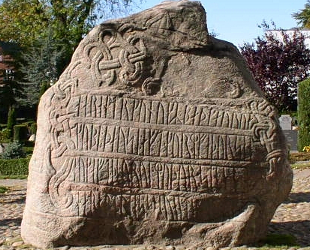

Location: Thyrasvej 1, Jelling, Southern Denmark Map
Jelling Runic Stones is a collection of boulders with historic records that date back to the 10th century. They are covered by medieval runes or writings that depict the story of its people. Due to its importance Jelling Runic Stones were added to UNESCO World Heritage Site. Jelling Runic Stones today stay on the grounds of the church. They are covered by runes or medieval writings that tell a story about ancient Vikings and their royals that lived here in these lands around 955 AD. Their Danish King Gorm the Old along with his wife Tyuroy are buried under burial mounds not far from these Jelling Stones. Two larger stones carry a historically important information about the heirs of the Vikings. One of the smaller stones stated that King Gorm ruled this part of Denmark in the middle 10th century. The second runic stone tell the story of the first heir to the Danish King Harold Bluetooth who ruled these lands after the death of King Gorm. King Harold became famous among the Danes for his successful military invasion of Norway and bringing Christianity to Danes. Today Committee for Cultural Heritage of Denmark placed Jelling Runic Stone are placed under the glass cases that protect them from the harsh north winds and unforgiving weather.
The Great Jelling Stone
It is difficult to
schedule the erection of the Great Jelling Stone, but it was
probably erected between 960 and 985 by Gorm and Thyra's son Harald
Blåtand in Jelling in memory of his parents. The stone inscription
also tells of Harald's merits. He gathered Denmark and made the
Danes Christians. The stone consists of three different sides. One
side is engraved with runes, the other is a fabled animal, and on
the third is a crucifixion image of Christ.
The stone is made
in Mammenstil, one of the late Viking era style periods. In the
cutting itself, the stone bears the mark of Western European
influence. In contrast to the traditional Nordic with deep engraving
in hard granite, this stone has been freely cut, so the dragonfly
and the other decoration form a flat relief. It is a technique used
for softer sandstones in i.a. Germany and England. The only Nordic
style reliefs are made of limestone or sandstone. The only direct
European parallel is Irish granite crosses. The rune inscription
itself is also made according to Western European tradition, instead
of the traditional vertical or ribbon text, this stone has text in
horizontal lines. This follows the Latin form, thereby mimicking a
document written on parchment. Preben Meulengracht Sørensen has
pointed out that this marks a shift in the way the rune stone was
used. Traditionally, the purpose of the inscription had been to
describe and maintain, while this stone had a communicative purpose;
it should tell the king's message. Against this background,
Meulegracht-Sørensen has described this stone as one of the oldest
relics of the beginning Latin writing culture in the Nordic
countries.
The stone is often referred to as "the baptismal
certificate of Denmark", and it has also been erected for the
purpose of proclaiming the king's baptism and thereby establishing
Christianity as the country's state religion. The stone marks one of
the important stages in the lengthy process that led to the change
of religion in the North. The Christ depicted on the stone does not
resemble the suffering figure known a few hundred years later. Here
he is portrayed as a triumphant king who ascends the Tree of Life,
ie. cross. It is thus present, although not depicted directly.
Christ on the Jelling Stone is a Skt. Helper figure, ie a clothed
Christ with shoes and gloves. In Denmark there is otherwise only one
Skt. Helps depicted on the church bell in Kværs from 1422, which has
come from Kliplev.